Normans & Natives in Medieval Connacht
Published in Features, Issue 2 (Summer 2002), Medieval History (pre-1500), Volume 10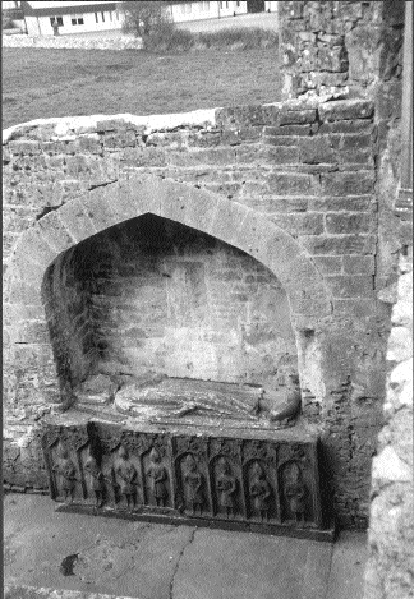
Tomb of Feidlim Ua Conchobair
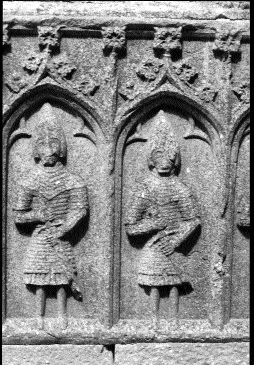
Galloglass slabs, in the Dominican abbey, Roscommon. (Freya Verstraten)
Before the second half of the thirteenth century no Irish king of Connacht was able to maintain himself without the support of the leading Anglo-Norman family there, the de Burghs. The head of the family, Richard de Burgh, was decisive in the king-making process in Connacht: his choice of king usually prevailed. And so it was that when King Áed Ua Conchobair (O’Connor) rebelled in 1230, Richard was able—in effect—to depose him and give the kingship to Áed’s cousin, Feidlim.
Áed was the son of Ireland’s last high-king, Ruaidrí Ua Conchobair, who had submitted to King Henry II of England in 1175 by the Treaty of Windsor. Over the years Anglo-Norman presence and power intensified and became an increasingly important factor in native Irish politics. In 1226, during the reign of Feidlim’s brother, also named Áed, the province had been split due to what the then king of England, Henry III, considered to be Áed’s forfeiture of the land. Richard de Burgh was granted the greater part of Connacht, whereas the five cantreds which Henry retained for himself (the ‘King’s Five Cantreds’) were all Áed was to hold of the province. So, though Áed and his successors were called ‘kings of Connacht’, they officially held an area comprised of present-day County Roscommon and adjacent lands. Moreover, even this slim hold of the kings of Connacht was to be reduced over the years to come.
Though Feidlim is very likely to have been a candidate for the kingship after the death of his brother Áed in 1228, his appointment was by no means secured by his close blood-relation to the previous king (indeed, kings) of Connacht. In fact, as was very often the case, a succession-dispute broke out after the murder of Áed and Feidlim’s candidature is not even mentioned in the annals at this stage. A feud between two rival branches of the Ua Conchobair family, the descendants of Ruaidrí and the descendants of Cathal Crobderg, had commenced decades earlier and was to continue for many more to come. It was Feidlim’s cousin, the aforementioned Áed, son of Ruaidrí Ua Conchobair, who emerged triumphant. Áed had, like Feidlim would do later, relied on de Burgh’s support to make good his claim. He forfeited Richard’s aid when in 1230 he was persuaded to rebel against the Anglo-Normans and he and his Irish allies took a vow never to accept a lord who would make them submit to the foreigners. De Burgh responded by assembling a host: he advanced against the rebellious king and defeated him. Richard then gave the kingship of Connacht to Feidlim.
Imprisonment
Feidlim had great difficulty holding on to this greatly reduced area. As early as 1231 he apparently offended Richard, and was subsequently imprisoned by him.
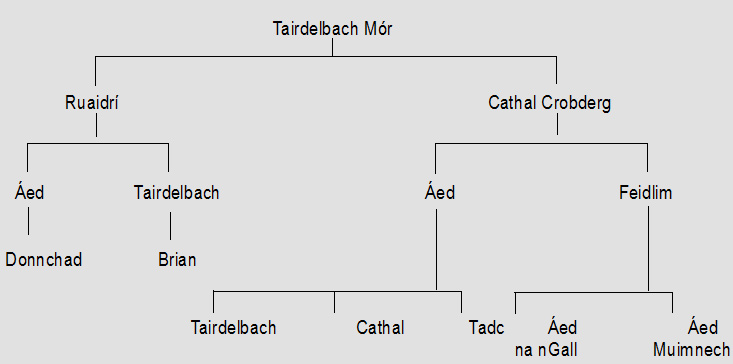
It was notably Áed, son of Ruaidrí, the man who had so ostentatiously rebelled against Anglo-Norman supremacy, who was reinstated by de Burgh as king. Whilst he kept Feidlim in the castle of Meelick, Richard and his allies proceeded to build and rebuild castles in Connacht.
Feidlim’s rescuer was none other than the king of England himself. Due to dissension between Richard’s uncle, Hubert de Burgh, and Henry III, as well as the account Richard had left after having been in the office of justiciar or chief governor of Ireland, Richard was now dispossessed of his lands. Of more direct consequence for Feidlim was the order Henry issued for him to be released from prison. De Burgh seems to have obeyed the king: Feidlim was liberated soon after. But Richard refused to surrender Meelick in spite of Henry’s threat that if he would not deliver the castle to the justiciar, he would ‘incur perpetual infamy’. When, therefore, Feidlim wrote to Henry asking to be received in London so that the two kings could converse about ‘their affairs’, Henry made reply (May 1233) that the Irish king would be welcome, if only he would first take the castle of Meelick and impose peace upon the province. Feidlim demolished several castles, notably the ones that had just been built and rebuilt by Richard and his allies, and the annals indeed record that he restored peace in Connacht. Even so, he failed to take Meelick, and Henry less than two months later appealed to the justiciar, as he had done before, to make de Burgh surrender the castle and impose peace.
Beyond the Five Cantreds
Usually Bréifne, situated to the north-east of Connacht, was an independent territory. Both the Uí Domnaill (O’Donnells) of Tír Conaill and the Uí Chonchobair claimed overlordship, however. When therefore in 1233 William Gorm de Lacy (half-brother of Walter, Lord of Meath) interfered in this region, this was not much appreciated by the king of Connacht. William in fact died in an attack against the Uí Ragallaig (O’Reillys) of East Bréifne, but Feidlim nevertheless retaliated for the de Lacy interference by burning several towns in the lordship of Meath a year later. The lord of Meath himself was absent. Both he and Richard de Burgh, who was trying hard to get back in Henry’s favour, were fighting in Leinster against one of the king of England’s enemies, Richard Marshal, Earl of Pembroke and Lord of Leinster. Richard’s strategy succeeded. Due to his active role in the war against Marshal he was reinstated in Connacht and received possession of the province for a fine of 3,000 marks (£2,000) in 1235.
After he had retaken possession of Connacht, he went raiding in both Connacht and Thomond. When Richard entered Thomond, Feidlim marched after him in aid of the Uí Briain (O’Briens), and to whom Feidlim was related through his mother. But he and the Uí Briain were defeated. Feidlim now found it hard to maintain his position and fled north to the Uí Domnaill of Tír Conaill. The two branches of the respective families seem to have been on good terms in this period, despite the claim they both had on Bréifne. Possibly the marriage between Feidlim’s sister Lasairfina and Domnaill Mór Ua Domnaill had already been arranged (they were married at the latest by 1239); the union seems either to have established or reflected the good relations between Ua Conchobair and Ua Domnaill.
After his absence in the north, peace was concluded between Feidlim and the justiciar and the former again obtained the Five Cantreds. He then broke down the castle of Meelick, something he had been ordered to do several years before. Even so, Feidlim was not able to consolidate his regained position. In 1236 he was banished by the justiciar Maurice Fitz Gerald (notably his ‘gossip’ or the sponsor at his birth), after Richard de Burgh had gone to England. The annals tell us that Maurice set up a meeting to capture Feidlim, but that the latter was warned beforehand and so managed to avoid capture. Feidlim again fled to Ua Domnaill, and in his stead Brian, son of Tairdelbach, son of Ruaidrí (i.e. the son of Feidlim’s cousin) was installed. But Brian was unable to establish peace and for his brief reign the annals paint a picture of death and devastation.
Feidlim in the meantime was invited by his nephews (sons of his brother Áed) and other Connachtmen to return to the province. But although Feidlim was able to raise support among the men of Connacht and assemble an army around himself, he was not to avail of their aid for long. As he advanced against the castle of Rinndown where a garrison had been placed, he was abandoned by his men who instead of taking the castle, took booty:
A pitiful act, their lord [Feidlim], their honour and their valour were abandoned for booty and cattle which profited them nought, and they deserted their lord until out of the four battalions which had been under him he had but four single horsemen left, and the high-king’s voice was broken in trying to recall and rally them.
(Annals of Connacht)
In the king’s service
In 1237 Feidlim, his nephews and the Uí Ragallaig (amongst others) defeated the descendants of Ruaidrí, Meic Diarmata (Mac Dermots) and troops led by the justiciar. Feidlim made peace and received the Five Cantreds yet again. But he was unable to maintain peace for long. This time his nephew Tadc, son of Áed, son of Cathal Crobderg, killed Donnchad, son of Áed, son of Ruaidrí. Moreover, Tadc raided Uí Ragallaig territory. Feidlim could not let this go unpunished if he intended to be a good overlord over Bréifne, and so went in pursuit of his nephew. On his instigation, Tadc was captured by the Uí Ragallaig, who had fostered Tadc’s brother, Cathal.
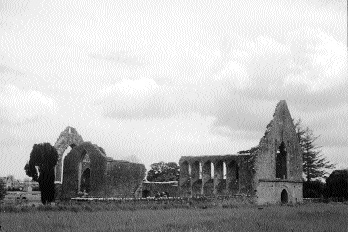
The Dominican abbey, Roscommon-founded by Feidlim Ua Conchobair in 1253. (Freya Verstraten)
Cathal now turned against his foster-family and plundered their lands: the Uí Ragallaig retaliated by emasculating and blinding Tadc. Feidlim did not concur with the severity of this retribution and advanced against the Uí Ragallaig. In view of the lack of evidence of further continuing open enmity, peace must have been concluded between the families.
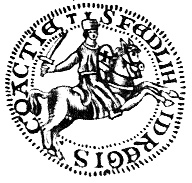
Feidlim Ua Conchobair’s seal.
And that was not the sole cause of Feidlim’s troubles. Another one of his problems arose from the fact that Henry III wanted higher profits from his Irish lands as he needed money for conducting wars in Wales and France. Therefore, he ordered the encastellation of Connacht, in anticipation of further settlement and as a check on the militant Connachtmen. Moreover, Richard de Burgh commenced the sub-infeudation of the province.
In 1240 Feidlim travelled to the court of the king of England—a very unusual journey for an Irish king to undertake. There, we are told, he complained to Henry of the Anglo-Normans and, according to one of the annals, of the Irish as well. What his complaint consisted of the sources do not say, and it could refer to any of above-mentioned problems Feidlim had to deal with. In any case, he received another grant of the Five Cantreds and was very content on returning home. It is likely that some sort of agreement was made between the two kings. Henry seems to have offered aid to Feidlim in times of uprising and perhaps check the growing power of de Burgh, in return for which Feidlim was to assist the justiciar and render military service to the king.
This seems likely in view of what happened next. In 1244 Henry planned an expedition against Alexander II, king of Scotland. Henry requested that some of his Irish subjects—among them Feidlim—and the justiciar should come to his aid. The expedition to Scotland was cancelled as Alexander made peace, and Henry sent letters to Ireland saying that Irish aid was now not required, but that they should be ready for an expedition to Wales. This planned campaign against Dafydd of Gwynedd took place in the summer of 1245. Of the invitees, it is only evident that the justiciar, Feidlim, and an army of Irish foot soldiers came to reinforce Henry’s army. However, on their arrival they were much delayed as they had spent time despoiling Anglesey. Henry’s campaign in Wales was not a success and Maurice Fitz Gerald was partly blamed for this: he was replaced in office by John Fitz Geoffrey. (Also, he was reported to have killed Irishmen in Anglesey and the king intended to prosecute him for that.) Feidlim on the other hand was rewarded for his service (he received a gift in 1247, possibly in connection with the losses he had suffered in Anglesey) and Henry styled him ‘king of Connacht’ once again. Before the campaign in Wales, he referred to Feidlim as a ‘son of the [late] king of Connacht’. Henry’s manner of styling of the Connacht king naturally reflected his opinion of Feidlim’s standing.
Gaelic resurgence
The second half of the 1240s saw anti-settler activities in Leinster and Munster and there was unrest in Connacht also. In 1243 Richard de Burgh had died on one of Henry’s expeditions in France. His lands in Ireland were held by the appointed custodian Peter de Birmingham until Richard’s heir would come of age. Peter travelled to Sligo in 1249, a move that alarmed the Connachtmen. They did not, however, inform Feidlim of this fact, as he had shown himself to be in good standing with the Anglo-Normans recently. Instead, they notified Feidlim’s son, Áed. Áed marched against Peter and the latter was killed. After this, Maurice Fitz Gerald (no longer justiciar, but still a major landholder) marched into Connacht. Feidlim now found himself in a precarious situation, because of the harm his son had done the Anglo-Normans. He decided to flee to Bréifne and from there to the north of Ireland. The justiciar, Maurice Fitz Gerald and other Anglo-Normans ravaged first Bréifne, then the Síl Muiredaig (Sil Murray) in central Connacht, and set up Tairdelbach, son of Áed, son of Cathal Crobderg—who notably had attacked the settlers two years before—as king of Connacht.
Áed had brought on great trouble for his father. This time, Feidlim did not take refuge with Ua Domnaill, but instead fled to Ua Néill of Tír Eógain. There, he was able to assemble a great army and march into Bréifne. From there he then travelled to Connacht and exiled his nephew, ‘King’ Tairdelbach. Again, peace was concluded and Feidlim was reinstated. From this time on his son Áed acted with authority in both Bréifne and Connacht.
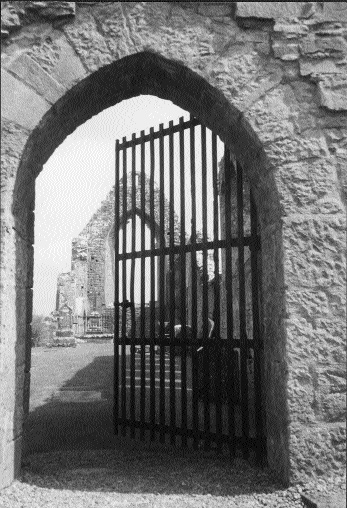
The Dominican abbey, Roscommon-Feidlim Ua Conchobair’s last resting place. (Freya Verstraten)
The mid-thirteenth century was a period of financial distress for the king of England. For want of land in England to grant to royal favourites, Henry started parcelling out land in Ireland. Personal friends and relatives were granted land within the Five Cantreds in 1253 and the king’s half-brother, Geoffrey de Lusignan, was granted land in Connacht a year later. At the same time, the heir apparent, Henry’s eldest son Edward, was made Lord of Ireland.
Feidlim, in response to the curtailment of his power, sent envoys to the king in England. Henry ordered that Feidlim’s lands should be left in peace, but at the same time Geoffrey was to choose two cantreds and Edward was to have ‘the best’ cantred. The king then wrote to Feidlim saying that he had ‘done him no injury’ as Feidlim’s relatives had offered large sums of money to the king to be granted those lands. On top of all this, Feidlim was now referred to by Henry as ‘an Irishmen’ or else simply by his Christian name instead of the earlier use of the term ‘king of Connacht’ or even ‘son of a former king of Connacht’. Clearly, Feidlim was losing standing in Henry’s eyes.
More foreigners
The annals report that in 1255 peace was made between Feidlim and Walter de Burgh. Walter was Richard’s son and had been granted possession of his father’s lands which had until then been held in custody. However, this peace either did not last very long or apparently did not apply to Feidlim’s son, Áed, because only a year later Walter attacked Áed. The annals are very poetic in their description of Áed’s qualities (e.g. his valour) displayed in the battle (of Magh Slecht) which ensued. At this stage Áed is nicknamed ‘na nGall’ (of the foreigners) but this probably refers to his connections to the men from the Hebrides, the Innse Gall, not the Anglo-Normans. Áed married a daughter of the Lord of the Isles in 1259 and had established relations with her powerful family perhaps as early as 1247. Feidlim fought at Magh Slecht also, and it was to him the hostages were given at its conclusion.
But it was Áed who met the new justiciar, Alan de la Zouche, in Rinndown. The two drew up a peace that included a stipulation that Ua Conchobair ‘should suffer no diminishing of territory or estate as long as this justiciar held office in Ireland’. Afterwards, Feidlim also met with the justiciar, as well as with Walter de Burgh and other Anglo-Norman chiefs in Athlone and peace was concluded between them. According to the annals Feidlim obtained a grant of the Five Cantreds once more, but the evidence in the Pipe Rolls suggests he held only three cantreds. Although it is not clear what the size Feidlim’s holding was at this point, he remained active outside the King’s Cantreds also.
Áed na nGall
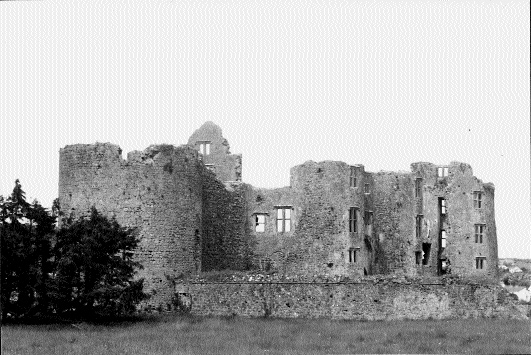
Roscommon castle, built by the justiciar in the reign of Feidlim’s successor, íed na nGall. (Freya Verstraten)
Whilst Feidlim slowly but surely retreated to the background, his son Áed became more and more active. Áed acted as overlord over Bréifne, and, moreover, met Tadc Ua Briain and Brian Ua Néill at an anti-settler meeting in Cáel Uisce [Fermanagh], where the men gave Brian the ‘kingship of the Gaels’. Feidlim was left out completely, nor did he want anything to do with these activities. In 1260 the alliance made at Cáel Uisce was put to the test, though by now Tadc had died. The battle of Down was a disaster: the Irish were defeated by colonists and Brian was killed. It is even reported that his head was sent over to London—a deterrent not often resorted to and which demonstrates the importance attached to the rebellion by the Anglo-Normans.
Another anti-Anglo-Norman activity Áed was involved in was the invitation sent to King Håkon IV of Norway. In the summer of 1263 Håkon was in the Isles off Scotland and was asked by the Irish to help rid them of the Anglo-Normans. The Norwegian king, however, was dissuaded from doing so by his own crew and soon after died, so nothing came of this. It is nevertheless evident that by now the opposition against the invaders was seen in a broader perspective. No longer did the Irish aim for purely regional or short-term goals. Feidlim’s policy of appealing directly to the king of England and being loyal to him had not borne fruit. He was not the only one who had tried and failed and the second half of the thirteenth century seems to have brought dissatisfaction among the younger generation.
After the battle of Down, de Burgh advanced in a punitive campaign against the Uí Chonchobair. To convince the king of England of his innocence, Feidlim wrote him a letter in 1261 pledging his loyalty and saying that ‘for no promise made to him by the Irish had he receded, or would he recede from the K[ing]’s service’. A year later, the Anglo-Normans again raised an army to attack Feidlim and his son. Peace was made and, no doubt as a sign of trust between them, Áed and Walter are reported to have slept in the same bed. Nevertheless, Walter attacked Feidlim again one year later—peace was clearly by no means everlasting.
Feidlim died in the first half of 1265, leaving behind at least two sons: Áed na nGall and another, illegitimate, son also called Áed. The former immediately succeeded his father in the kingship. Feidlim was buried in Roscommon, in the Dominican abbey he had founded in 1253, where the remains of the tomb and effigy said to be his can still be seen. The annals are full of praise of the late king, for being full of honour and valour, helping his friends ‘on every side’ and fighting his enemies. Loyal to the king of England, and taking on elements of Anglo-Norman culture (e.g. his seal, and his effigy, which is carved in English style), did not seem to have brought him great advantage. At the end of his reign the territory the kings of Connacht held was smaller than ever before. Officially, that is, since they still operated outside of this confined region as they had done from the early medieval period on.
Freya Verstraten is a Government of Ireland Scholar in the Department of Medieval History, Trinity College, Dublin.
Further reading:
S. Duffy, Ireland in the Middle Ages (London 1997).
R. Frame, Colonial Ireland 1169-1369 (Dublin 1981).
A.J. Otway-Ruthven, A History of Medieval Ireland (New York 1969).
















